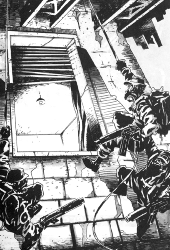 The current system has a task resolution system where you roll; if you roll
above the target number you succeed, otherwise you fail. This is a bit
black-and-white for me, so I created a different table, and a slightly
different system of rolling the die.
First the die. Under the CP2020 rules, if you roll a 1, you have fumbled,
and you have to rol on the fumble table. On a roll of 10, you have a
critical success; roll again and add the result to the roll. I do things
differently.
The critical success is about the same; roll a D10. If you roll a 10, you
roll again and add the second die to your roll. Continue until you don't
roll tens anymore. This is not so much different from the official rules.
The fumble, however, works different. When you roll a 1, you don't
automatically fumble. You roll the die again, and subtract it from your
total. If you rolled a 10, the second time, roll again and subtract that
roll from your total as well. Keep rolling until you don't roll tens
anymore.
This could let you end up with a large negative score. 'What's the point of
that', you might wonder. Well, that's where the task resolution table
comes in. Compute the difference between the target number and the roll,
and compare this to the table. Negative numbers indicate the amount that
you missed the target number by, positive numbers indicate by which you
exceeded it.
The current system has a task resolution system where you roll; if you roll
above the target number you succeed, otherwise you fail. This is a bit
black-and-white for me, so I created a different table, and a slightly
different system of rolling the die.
First the die. Under the CP2020 rules, if you roll a 1, you have fumbled,
and you have to rol on the fumble table. On a roll of 10, you have a
critical success; roll again and add the result to the roll. I do things
differently.
The critical success is about the same; roll a D10. If you roll a 10, you
roll again and add the second die to your roll. Continue until you don't
roll tens anymore. This is not so much different from the official rules.
The fumble, however, works different. When you roll a 1, you don't
automatically fumble. You roll the die again, and subtract it from your
total. If you rolled a 10, the second time, roll again and subtract that
roll from your total as well. Keep rolling until you don't roll tens
anymore.
This could let you end up with a large negative score. 'What's the point of
that', you might wonder. Well, that's where the task resolution table
comes in. Compute the difference between the target number and the roll,
and compare this to the table. Negative numbers indicate the amount that
you missed the target number by, positive numbers indicate by which you
exceeded it.
| -20 or more | Major negative effect |
| -19 to -15 | Negative effect |
| -14 to -10 | Minor negative effect |
| -9 to -5 | Failure |
| -4 to -1 | Just failed |
| 0 | Just failed; next action +5 modifier |
| +1 to +4 | Just made it |
| +5 to +9 | Made it |
| +10 to +14 | Minor positive effect |
| +15 to +19 | Positive effect |
| +20 or more | Major positive effect; +10 IP in the skill |
Example 1: Tasha tries to get past an electronic lock of strength 15. Her
TECH is 6 and her Electronic Security skill is 8. She would succeed when
the player rolled a 2 or more. The player rolls.. a 1. Rolling again, the
result is 10, so a second die is rolled. A 10 again, and the third die
gives a 6. The result is 6+8+1-10-10-6, or -11, vs. a difficulty of 15, for
a total difference of 26. In a moment of inattention, Tasha touches the
wrong wire. 220 volts chase to her body, and the resulting spasms set off
the alarm. Her companions curse, grab their stuff and run away while Tasha
turns black, crispy and smoking.
Example 2: Being pursued over the rooftops, Mynar comes to the edge of the
roof. Another roof is three meters away and two meters lower, so Mynar
jumps. The GM sets the difficulty to 20. Mynar has a REF of 7 and an
Athletics skill of 6. The player takes the dice and rolls a 7, for a total
of 7+6+7, or 20, vs. a difficulty of 20. Mynar floats through the air and
notices that she won't make it to the other side. She manages to grab the
roof's edge with her fingertips while she smashes against the wall (the
GM's definition of 'just failed' - he's a wuss). Next round she climbs up
the roof - difficulty 15, says the GM. Another 7 is rolled, for a total of
7+6+7+5 (+5 was the bonus from the last roll), or 25, vs. a difficulty of
15; a difference of +10, or a minor positive effect. The GM rules that
Mynar gets on the roof in half the time that it would normally have cost,
so she is on her two feet again and ready to run away when her pursuers
arrive and start shooting.
|
